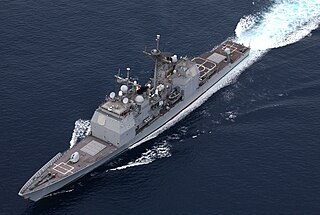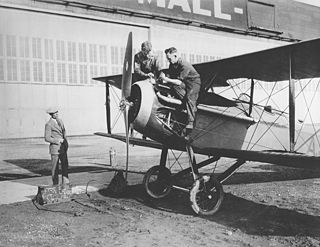
The Qatar Armed Forces are the military forces of the State of Qatar. Since 2015, Qatar has implemented mandatory military conscription with an average of 2,000 graduates per year. As of 2010, Qatar's defence expenditures added up to a total of $1.913 billion, about 1.5% of the national GDP, according to the SIPRI. Qatar has recently signed defence pacts with the United States in 2002 & 2013, with the United Kingdom in 2020, and with France in 1994.
The Lockheed Martin Corporation is an American aerospace and defense manufacturer with worldwide interests. It was formed by the merger of Lockheed Corporation with Martin Marietta in March 1995. It is headquartered in North Bethesda, Maryland, in the Washington, D.C. area. As of January 2022, Lockheed Martin employs approximately 115,000 employees worldwide, including about 60,000 engineers and scientists.

The M142 High Mobility Artillery Rocket System (HIMARS) is a light multiple rocket launcher developed in the late 1990s for the United States Army and mounted on a standard U.S. Army Family of Medium Tactical Vehicles (FMTV) M1140 truck frame.

The MGM-140 Army Tactical Missile System is a tactical ballistic missile designed and manufactured by the US defense company Ling-Temco-Vought (LTV), and later Lockheed Martin through acquisitions. It uses solid propellant, is 13 feet (4.0 m) long and 24 inches (610 mm) in diameter, and the longest-range variants can fly up to 190 miles (300 km). The missiles can be fired from the tracked M270 Multiple Launch Rocket System (MLRS) and the wheeled M142 High Mobility Artillery Rocket System (HIMARS).

The Aegis Combat System is an American integrated naval weapons system, which uses computers and radars to track and guide weapons to destroy enemy targets. It was developed by the Missile and Surface Radar Division of RCA, and it is now produced by Lockheed Martin.
Loral Corporation was a defense contractor founded in 1948 in New York by William Lorenz and Leon Alpert as Loral Electronics Corporation. The company's name was taken from the first letters of each founder's surname.

The AGM-154 Joint Standoff Weapon (JSOW) is a glide bomb that resulted from a joint venture between the United States Navy and Air Force to deploy a standardized medium range precision guided weapon, especially for engagement of defended targets from outside the range of standard anti-aircraft defenses, thereby increasing aircraft survivability and minimizing friendly losses. It is intended to be used against soft targets such as parked aircraft, trucks, armored personnel carriers (APCs), and surface-to-air missile sites (SAMs). Prior to launch, it is given a destination through either a predesignated waypoint or a point marked through a targeting pod. It glides, using two wings that pop out for added lift, to the marked destination and dispenses submunitions in a short, roughly linear pattern. The designation of the Joint Standoff Weapon as an "air-to-ground missile" is a misnomer, as it is an unpowered bomb with guidance avionics, similar to the older GBU-15.

The M270 Multiple Launch Rocket System is an American armored self-propelled multiple launch rocket system.

Vought was the name of several related American aerospace firms. These have included, in the past, Lewis and Vought Corporation, Chance Vought, Vought-Sikorsky, LTV Aerospace, Vought Aircraft Companies, and Vought Aircraft Industries.
Ling-Temco-Vought (LTV) was a large American conglomerate which existed from 1961 to 2001. At its peak, it was involved in aerospace, airlines, electronics, steel manufacturing, sporting goods, meat packing, car rentals, and pharmaceuticals, among other businesses.

Terminal High Altitude Area Defense (THAAD), formerly Theater High Altitude Area Defense, is an American anti-ballistic missile defense system designed to shoot down short, medium, and intermediate-range ballistic missiles in their terminal phase by intercepting with a hit-to-kill approach. THAAD was developed after the experience of Iraq's Scud missile attacks during the Gulf War in 1991. The THAAD interceptor carries no warhead, instead relying on its kinetic energy of impact to destroy the incoming missile.
The Medium Extended Air Defense System (MEADS) is a ground-mobile air and missile defense system intended to replace the Patriot missile system through a NATO-managed development. The program is a development of the United States, Germany and Italy.

The MGM-166 LOSAT was a United States anti-tank missile system designed by Lockheed Martin to defeat tanks and other individual targets. Instead of using a high explosive anti-tank (HEAT) warhead like other anti-tank missiles, LOSAT employed a solid steel kinetic energy penetrator to punch through armor. The LOSAT is fairly light; it was designed to be mounted onto a Humvee light military vehicle while allowing the vehicle to remain air-portable. LOSAT eventually emerged on an extended-length heavy-duty Humvee with a hard-top containing four KEMs used by special operations. Although LOSAT never "officially" entered service, it was used for the smaller Compact Kinetic Energy Missile.

The AGM-158 JASSM is a low detection standoff air-launched cruise missile developed by Lockheed Martin for the United States Armed Forces. It is a large, stealthy long-range weapon with a 1,000-pound (450 kg) armor piercing warhead. It completed testing and entered service with the U.S. Air Force in 2009, and has entered foreign service in Australia, Finland, and Poland as of 2014. An extended range version of the missile, the AGM-158B JASSM-ER, entered service in 2014 as well as an anti-ship derivative, the AGM-158C LRASM, in 2018. By September 2016, Lockheed Martin had delivered 2,000 total JASSMs comprising both variants to the USAF.
BAE Systems Electronic Systems (ES) is one of three operating groups of BAE Systems Inc., the North American subsidiary of the British global defence contractor BAE Systems PLC.
The AGM-169 Joint Common Missile (JCM) was a tactical air-to-surface missile program (2002–2007) developed by the Lockheed Martin corporation for the United States military aircraft, such as attack and utility helicopters, strike fighters and fighter-bombers.

The Texas Engineering & Manufacturing Company (TEMCO), also known as Temco Aircraft Corporation, was a U.S.-based manufacturing company located in Dallas, Texas, USA. It is best known for eventually forming part of the conglomerate Ling-Temco-Vought.
Lockheed Missiles and Space Company (LMSC) was a unit of the Lockheed Corporation "Missiles, Space, and Electronics Systems Group." LMSC was started by Willis Hawkins who served as its president. After Lockheed merged with Martin-Marietta the unit became known as "Lockheed Martin Missiles and Space". Located in Sunnyvale, California adjacent to Moffett Field, it operated a major satellite development and manufacturing plant.

The AGM-158C LRASM is a stealth air launch anti-ship cruise missile developed for the United States Air Force and United States Navy by the Defense Advanced Research Projects Agency (DARPA). Derived from the AGM-158B JASSM-ER, the LRASM was intended to pioneer more sophisticated autonomous targeting capabilities than the U.S. Navy's current Harpoon anti-ship missile, which has been in service since 1977.
In air and missile defense (AMD), the Integrated Air-and-Missile Defense system (IAMD) is an SMDC research program to augment the aging surface-to-air missile defense systems and to provide the United States Army with a low-cost, but effective complement to kinetic energy solutions to take out air threats. Brigade level higher energy lasers are used in truck mounted systems called HELMTT. At lower levels, the Army needs to develop interceptors that don't cost more than small, unmanned aircraft systems. In early research they have successfully used 5-kilowatt lasers on a Stryker combat vehicle. The Mobile Expeditionary High-Energy Laser (MEHEL) was used at MFIX at Fort Sill, Oklahoma, in the first half of April, 2017.












